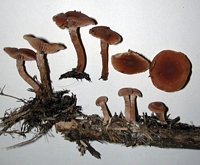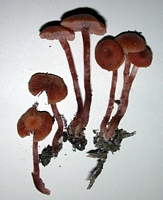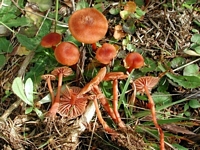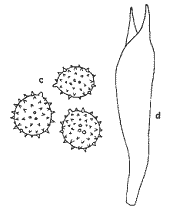|
 Laccaria fraterna Laccaria fraterna
SynonymsAgaricus fraternus
Naucoria fraterna
Laccaria ohiensis
Laccaria impolita
BiostatusPresent in region - Indigenous. Non endemic
Images (click to enlarge)
Caption: fruitbody
Owner: J.A. Cooper | 
Caption: fruitbody
Owner: J.A. Cooper | 
Caption: fruitbody
Owner: J.A. Cooper | 
Caption: L. ohiensis: c spores; d, basidium | |
Article: McNabb, R.F.R. (1972). The Tricholomataceae of New Zealand. 1. Laccaria Berk. & Br. New Zealand Journal of Botany 10(3): 461-484 (http://www.rsnz.org/publish/abstracts.php).
Description: PILEUS: 1-3.5 cm diam., hemispherical when young, convex
to plano-convex at maturity, centre of pileus often truncate and flattened,
or occasionally centrally depressed, hygrophanous, non-viscid, inconspicuously
pellucid-striate at margins when wet, not so when dry, finely furfuraceous,
reddish brown to dark reddish brown, drying pallid fawn to buff. Cuticle composed
of unspecialised, repent, parallel or slightly interwoven, thin-walled, clamped
hyphae 7-14 µm diam. LAMELLAE: adnexed to adnate, distant, intermixed, thick,
to 5 mm deep, flesh pink, glaucous. STIPE: 2.5-7 cm long, ± equal or slightly
tapering apically, 2-5 mm diam., dry, hollow, often twisted, coarsely and sparingly
longitudinally fibrillose giving stipe a silky sheen, reddish brown; flesh concolorous:
basal mycelium white.
SPORES: spore print white when fresh: spores globose
to subglobose, apiculate, hyaline, inamyloid, finely echinulate, 9.5-12.5 µm
diam. including spines, spines to 0.8 µm long, HYMENIUM: basidia clavate, hyaline,
32-45 X 7-10.5 µm, 2-(3)-spored, sterigmata to 10 µm long: paraphyses sparse,
simple, filiform, to 4 µm diam. HYMENOPHORAL TRAMA: regular, composed of tinted,
± parallel, long-celled hyphae; clamp connections present. CONTEXT OF PILEUS:
thin, reddish brown. SMELL AND TASTE: not distinctive. CHEMICAL CHARACTERS:
FeSO4 on pileus and context—rapidly dark grey; KOH and NH4OH on pileus and context—n.r.
Habitat: Gregarious to caespitose under introduced and
native trees and shrubs, occasionally not associated with woody plants.
Notes: Laccaria ohiensis has been comprehensively discussed by Singer (1967). In a correlative study of macroscopic and microscopic characters, and after taking into account ecological and phytogeographical considerations, Singer (1967) concluded that the species listed above as synonyms of L. ohiensis, each represented the sum of a series of collections from a particular phytogeographical region. New Zealand collections agree closely with L. lateritia, a species associated with Acacia, Eucalyptus, Pinus, and Quercus in North Africa, and it is perhaps significant that while L. ohiensis is relatively common in warmer parts of New Zealand, it has not been found in colder regions.
L. ohiensis is most probably an introduced species. It has been found only in habitats extensively altered by man, usually in association with introduced trees known to form ectotrophic mycorrhizas. A notable exception is the collection associated with the native mycorrhiza-former, Pomaderris kumeraho. In this instance, fructifications appeared around the base of a potted plant in a commercial nursery. The ability of Laccaria ohiensis to live as a facultatively mycorrhizal species is well illustrated by PDD 25969. The site on which these fructifications appeared had previously carried young Pinus radiata trees. Although these trees had all been cut down to ground level and the site made into lawn, fructifications of Laccaria ohiensis regularly appeared for at least seven years after the death of their higher plant partner.
L. ohiensis is characterised by the reddish brown pileus, longitudinally fibrillose stipe, bisporous basidia, and finely echinulate spores. It has not previously been recorded from New Zealand.
|